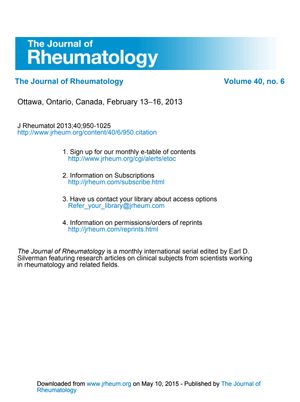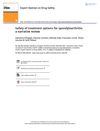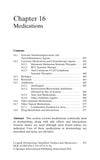Comprehensive Overview of Rheumatology Studies: Ottawa, Ontario, Canada, February 13–16, 2013
June 2013
in “
The Journal of Rheumatology
”

TLDR The document concludes that various findings in rheumatology offer insights into disease severity, treatment responses, and potential risks in medication, with some limitations due to unspecified participant numbers.
The document provided a comprehensive overview of various studies in the field of rheumatology, with findings relevant to the treatment and management of rheumatic diseases. Key points included:
1. North American Native populations with systemic sclerosis (SSc) have a more severe clinical phenotype than white patients.
2. Canadian systemic lupus erythematosus (SLE) patients experience high hospitalization rates.
3. Genetic variation may not significantly contribute to rheumatoid arthritis (RA) risk in certain Quebec populations.
4. Anti-Sa antibody titers could be a marker for RA disease activity.
5. UGT2B17 gene copy number variants are associated with ankylosing spondylitis (AS).
6. ANCA-associated vasculitis patients treated with plasma exchange had a one-year survival rate of 81.5%.
7. No significant increased risk of non-melanoma skin cancer from TNF-α inhibitor therapy.
8. Higher incidence of liver enzyme abnormalities in rheumatic patients treated with isoniazid for latent tuberculosis.
9. A decision aid for osteoarthritis (OA) management was well-received by patients.
10. Celecoxib may increase the risk of atrial arrhythmia in arthritis patients.
11. Antiplatelet agents reduced ischemic events in large vessel vasculitis.
12. Antibodies to homocitrullinated peptides were specific to RA.
13. Rituximab treatment for severe ANCA vasculitides in children showed a higher response rate than current treatments.
14. The Canadian Methotrexate and Etanercept Outcome (CAMEO) study found that etanercept (ETN) monotherapy was not as effective as the combination of ETN and methotrexate (MTX) in patients with active RA.
15. Integrating a nurse into outpatient rheumatologic practice improved patient care and treatment adherence.
16. Treating asymptomatic hyperuricemia might improve renal function, but evidence is lacking for prevention of gout, renal disease, or cardiovascular events.
17. Male patients with systemic sclerosis-associated pulmonary arterial hypertension (SSc-PAH) and idiopathic PAH (IPAH) had lower survival rates compared to female patients, although the differences were not statistically significant.
18. Flares in early RA are common, with patients often self-managing by taking more analgesics and reducing activities.
19. A renal transplant patient with chronic tophaceous gout successfully lowered uric acid levels using febuxostat.
20. Associations between autoantibodies and SSc types and organ involvement were found, with anti-centromere antibodies prevalent in limited cutaneous SSc.
21. Proteomic analysis of synovial fluid from Psoriatic arthritis (PsA) patients identified potential biomarkers.
22. Certolizumab pegol for RA showed no new safety concerns.
23. An 18-month study in Quebec City linked atypical femoral fractures to the use of bisphosphonates, proton pump inhibitors, statins, and vitamin D and calcium supplements.
The document did not specify participant numbers for all studies, which limits the strength of those findings. The largest study mentioned had 694 controls in the context of antiplatelet therapy.




